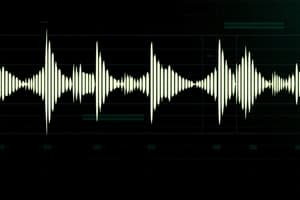Podcast
Questions and Answers
What year was the first cellular phone introduced in Japan?
What year was the first cellular phone introduced in Japan?
- 1979 (correct)
- 1976
- 1984
- 1982
What does the term 'carrier' refer to in communication technology?
What does the term 'carrier' refer to in communication technology?
- Carrier wave (correct)
- Source
- Information
- Baseband signal
Which modulation technique uses amplitude variation?
Which modulation technique uses amplitude variation?
- Am
- Pm
- Fm (correct)
- Baseband signal
What is the function of a receiver in communication systems?
What is the function of a receiver in communication systems?
The VHF spectrum operates within which frequency range?
The VHF spectrum operates within which frequency range?
What does 'demodulation' refer to in communication technology?
What does 'demodulation' refer to in communication technology?
Who is credited with the first patent for the typewriter?
Who is credited with the first patent for the typewriter?
Which frequency range is categorized as 'Super High Frequency' (SHF)?
Which frequency range is categorized as 'Super High Frequency' (SHF)?
What term describes the contamination of a signal due to external factors?
What term describes the contamination of a signal due to external factors?
Which inventor is recognized for the patent of the direct dial telephone?
Which inventor is recognized for the patent of the direct dial telephone?
Flashcards
Modulation
Modulation
The systematic alteration of the carrier frequency, amplitude, or phase to encode information.
Bandwidth
Bandwidth
The range of frequencies occupied by a signal.
Amplitude Modulation (AM)
Amplitude Modulation (AM)
A type of modulation where the amplitude of the carrier wave is varied to represent the information signal.
Frequency Modulation (FM)
Frequency Modulation (FM)
Signup and view all the flashcards
Demodulation
Demodulation
Signup and view all the flashcards
Transmitter
Transmitter
Signup and view all the flashcards
Receiver
Receiver
Signup and view all the flashcards
Transducer
Transducer
Signup and view all the flashcards
Radio Communication
Radio Communication
Signup and view all the flashcards
Attenuation
Attenuation
Signup and view all the flashcards
Study Notes
First Cellular Phone in Japan
- First cellular phone in Japan was in 1979
Frequency
- Frequency can be fed to antennas and radiate electromagnetic waves
Modulation
- Systematic alternation of a carrier in accordance with the message
- Amplitude of the carrier is varied according to the baseband signal
Year of the First Typewriter Patent
- 1850
Device that Extracts Desired Signal
- Receiver
Communication with Electronic Equipment
- Sorting and processing of information
- Telecommunication and receiver that carries signal
Communication Type
- Satellite communication
Medium Causes Signal Issues
- Cellular communication medium causes the signal to be amplified
Signal Strength Reduction
- Attenuation
Floppy Disc Invention Year
- 1972
Radar Acronym
- Radio Detection and Ranging
Ordered Sequence of Symbols
- Digital
Sonar Acronym
- Sound Navigation and Ranging
ABS CBN Frequency Spectrum
- SHF (300-3000 MHz)
VHF
- 3 to 30 MHz
Encoded System Conversion
- Demodulation
Signal Emission Device
- Transmitter
Electromagnetic Spectrum Portion
- Bandwidth
Carrier Frequency Variation
- PM (phase modulation)
Direct Dial Telephone Patent
- Alexander Graham Bell
Super High Frequency Range
- 30 to 300 MHz
Signal Interference Issues
- Interference can be from distortion, noise and other sources
Alexander Graham Bell's Birth Year
- 1847
Signal Transmission into Medium
- Baseband transmission
Studying That Suits You
Use AI to generate personalized quizzes and flashcards to suit your learning preferences.




